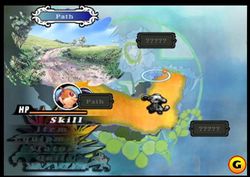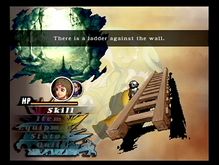Welcome to the SaGa Wiki! We have moved off Fandom very recently, so things are still being set up around here. Please note that some images did not successfully transfer, and will need to be manually reuploaded or replaced.
Note: Keep in mind that once you have an account, you must wait one day and make 5 edits to become autoconfirmed. This allows you to skip questions while editing, to create new articles, and to upload images.
Board game
The Board Game system is one of the innovative and key gameplay aspects to Unlimited Saga. It is the main dungeon/field view of the game whenever you undertake a main adventure or side-quest. The dungeon/field is broken up into a chess like board game, where you move your piece (a silver figure of the current main character) one place at a time, revealing more landscape and potential paths.
Movement[edit]
While each dungeon/field appears to be sprawling and non-linear, each movement is controlled by pushing the left analog stick in one of 8 radial directions. By pushing the analog stick in a certain direction, a wheel appears pointing in the direction you wish to go. By keeping the arrow pointed towards a potential path, marked by ?????, the character piece will move in that direction onto the next section of the map, and consume 1 turn. The path will then be given a brief description (like Path, Road, Cliff) and will appear on the overhead map (press Square to view).
Any dungeon/field that is part of a side-quest adventure will have a specific Turn Limit. This limits the maximum amount of actions you can perform before you fail the quest and are returned to the nearest town. If you fail a quest you can choose to attempt it again, with the Turn Limit being reset back to 0 each time. Main quests have an infinite Turn Limit and can be played as long as you require. If you fail an adventure, when you retry it any area(s) of the map previously uncovered will already be revealed.
Note: You can view the number of turns taken so far, the map Turn Limit and an overhead map of any panels/paths travelled by pressing Square.
Actions[edit]
When in a dungeon/field you can select a variety of actions (from the bottom left corner of the screen) to be performed in your current location;
- Skill - Use a specific skill (depending on a character's Growth Panels)
- Item - View, arrange and discard items
- Equipment - Check and alter your characters' equipment
- Status - View a character's indepth status, including; stats, growth rates, panel bonuses, attacks, spells
- Quit - Quicksave and quit to the main menu
By using Skills you can scan the current map panel for treasure, traps, monsters and engage each accordingly. Using any Skill will consume 1 turn. Additionally, you can press R3 (right analog stick) at any point to have the option to rest. Resting will consume 1 turn, but all the characters in your party will recover a portion of their HP (based on the character's HP recover stat listed under the 'Status' menu).
Battles[edit]
Battles occur when you encounter a monster on the same map panel you are on. Like your character, monsters move around the maps one panel at a time. When a monster occupies the same panel as you they may become hostile and attack, or have not noticed you and will remain peaceful. If a monster is present but hasn't attacked you have a variety of options you can perform;
- Choose to pre-emptively attack the monster yourself
- Use a Skill like 'Diplomacy' to remove the enemy from the map (consumes 1 turn and requires use of the Reel System)
- Simply ignore them and carry on (some monster types are easier to evade than others)
You can also scan the current dungeon/field for nearby monsters by using certain 'Detect' Skills. These will show a little red dot on the overhead map for every monster detected.
Note: When a battle is over you will be returned to the same panel on the map.
Treasure/Items[edit]
Treasure chests and items will occasionally turn up on map panels. You can also use the dungeon specific Skills to search for hidden treasures. Each type of dungeon requires a different scanning Skill in order to find treasure: Fields and open locations need Road Guide; Caves and enclosed natural spaces use Cave Guide; Structures and buildings require Architect. Each skill costs 1 turn per use.
- If an item/weapon/accessory/Magic Tablet is found you can simply choose to inspect it and it will be automatically picked up and added to your Items.
- When a treasure chest, or bag, is discovered you can do various things, such as; choose to open it, inspect it or use Skills on it. Some treasures have locks and deadly traps attached to them, which will require the use of certain Skills (Sharpeye, Locksmith, Defuse & Fortuneteller) to successfully disarm them and claim the item contained. These will consume 1 turn each (and require the use of the Reel System), but might save you from explosions, poison, damage, a mimic fight or breaking the item if you attempt to force open a lock.
Any treasure chest or item you find will remain on that map panel for the entire quest, enabling you to come back later for it (if you have enough turns).
Objects & Obstacles[edit]
You will come across various obstacles on the map. This can range from things like doors, and ladders (which offer access to other areas of a dungeon), to landslides and rivers (that can be traversed with the right Skill). Each object or obstacle can be overcome with the appropriate Growth Panel, such as Obstacle Crossing allowing you to scale landslides (these also consume 1 turn each). In many dungeons, there are bonus treasures, or strong monsters, hidden behind locked doors, or obstacles, making it crucial to explore every possible area of a map.



